This week in Florida the temperature reached the 70s. Yup, the 70s. You know what that means, right? It means summer is ending, fall is near, and the pool season is coming to a close. Luckily for us Floridians, we can stretch out our pool season for at least a few more weeks. However, our northern pool owners should start thinking about beginning the process of closing and winterizing their pools. Even pool owners in the South should take precautions to protect their pool equipment. Pool owners in the South are not exempt from water freezing temperatures.
The closer we get to winter, the more calls we receive about the the winterizing process. This is great news. It means pool owners are taking the necessary precautions to protect their pools. Although not a daunting task to complete, winterizing your pool the correct way is necessary to protect your pool and pool equipment from freezing. It also saves you time and money in the spring when temperature rises again.
To help with the winterizing process, we’ve compiled a checklist that pool owners can follow to ensure their pool is closed properly.
Step 1: Balance/ Adjust Chemical Levels
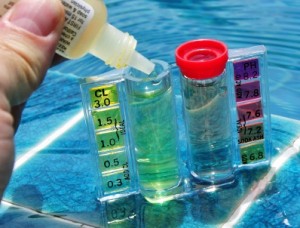 The very first thing you need to do is to balance all the chemical levels in your swimming pool. Make sure your pH, chlorine, and total alkaline levels are stable. Definitely make adjustments if necessary. You can purchase a quick test kit online or locally to perform quick and simple water tests. We also recommend you shock the pool to prevent stains from occurring. The reason you need to balance your pool before closing it is simple- you want to start the spring off fresh. Literally. There is nothing worse than delaying opening your pool because you have to spend weeks (and money) trying to balance your pool.
The very first thing you need to do is to balance all the chemical levels in your swimming pool. Make sure your pH, chlorine, and total alkaline levels are stable. Definitely make adjustments if necessary. You can purchase a quick test kit online or locally to perform quick and simple water tests. We also recommend you shock the pool to prevent stains from occurring. The reason you need to balance your pool before closing it is simple- you want to start the spring off fresh. Literally. There is nothing worse than delaying opening your pool because you have to spend weeks (and money) trying to balance your pool.
Step 2: Manage Your Water Levels
One of the first instincts as a first- time pool owner is to empty the pool completely during the winter. Please do not. Let’s say for a second that you do. As the water in the soil freezes, it expands. The expansion of the soil underneath your pool can literally pull the pool out of the ground. The weight of the water keeps the pool in place. This is also the same during a heavy storm.
*TIP*
If you live in a freeze area, drain your pool 4-6” below the skimmer.
If you live in a non-freeze area, keep your pool filled to the top.

Step 3: Clean Your Pool 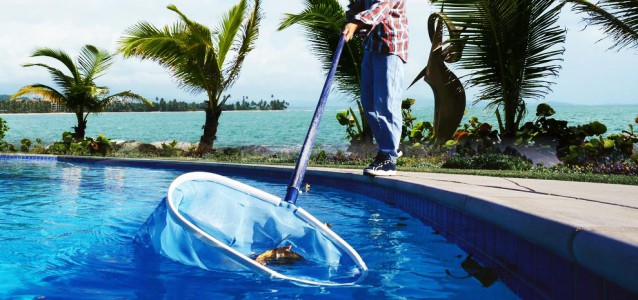
Next, you need to get down and clean your pool. No, I’m not talking about just turning on your automatic cleaner and letting it perform its magic. We recommend you take the time to not only vacuum your pool, but sweep and scrub your pool walls and skimmer baskets as well. If you only own a cleaner, you might want to consider buying a telescopic pole with a scrubber on the end. We all have those little, dirty areas in our pool that we sometimes wish we paid more attention to. This is the perfect time for it. Taking this extra precaution prevents future algae buildup and preserves the overall aesthetic of your pool.
Also remember to remove all floats, toys, ladders, and diving boards from your pool area. Store them in a safe place until you’re ready for them once your pool reopens.
Step 4: Backwash Your Filter
Before you begin the backwashing process, allow your pool pump to run a complete cycle. On average, it should take approximately eight hours to cycle your entire pool. After you backwash your filter, make sure you open both the drain at the bottom of the tank and open air relief valve (if you have one). This allows all the water in the tank to drain. If you’re uncertain about backwashing your filter, check out our how to guides on how to backwash your sand filter and how to backwash your d.e. filter.
Cartridge filters: Remove and inspect your filter cartridges. You can use a regular garden hose to rinse it off. At this time you can gauge whether or not replacing them is appropriate.
Sand filters: Backwash your filter as normal. It is highly recommended that you replace the sand in the tank now as opposed to when you reopen your pool in the spring. Keep your valve in the “WINTER” position afterwards.
DE filters: Much like sand filters, backwash your filter as normal. If your DE grids need to be replaced, this would be the perfect time to do so.

*TIP*
We recommend you wait until Spring to acid wash your filter. When you acid wash your grids and then let them sit for a few months, you run the risk of them being destroyed by the hardness of the acid.
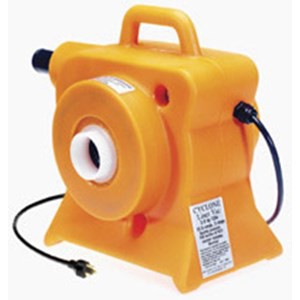 Step 5: Blow Pool Lines
Step 5: Blow Pool Lines
Of all the steps, this one is essential to maintaining your pool’s overall wellness. If you fail to blow out your lines and the temperature is at freeze level, it can (and will) destroy your piping and equipment. You can use a simple shop vac to blow your lines. You would blow water from the skimmer, through the equipment, back into the pool. Make sure you remove any directional fittings and install a freeze plug. Pumps, filters, heaters, and chlorinators should be drained. For extra insurance, you can flip your pump upside down and dump any excess water. Don’t forget to remove all drain plugs as well. You can close all exposed holes with a plug.
*TIP*
You can use some antifreeze in your water to help prevent the water from freezing. Keep in mind, this is NOT the same antifreeze you use in your car. DO NOT USE AUTOMOBILE ANTIFREEZE.
To avoid losing any. store all your plugs in the pump basket until next season.
Step 6: Shut Off Pool Equipment
Don’t forget to turn off all your pump equipment. You don’t want to leave something on accidentally. Better be safe and check it off your list.
Step 7: Cover Your Pool 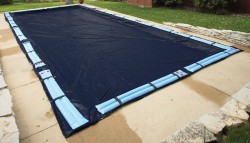
As you may know, there are several ways you can cover your pool. You have standard winter and mesh covers, leaf covers, and safety covers. We recommend you use a combination of the two to protect your pool. Whichever method you choose, make sure you utilize it during the winter. A lot of the hard work leading up to this point could be forfeited if you do not cover your pool.

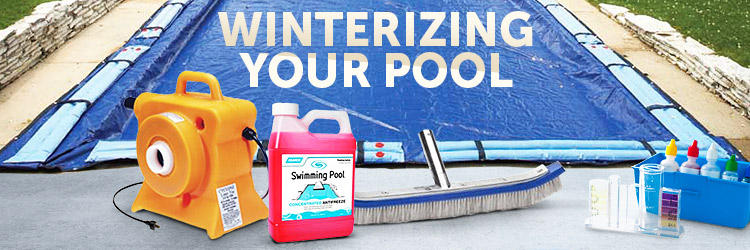


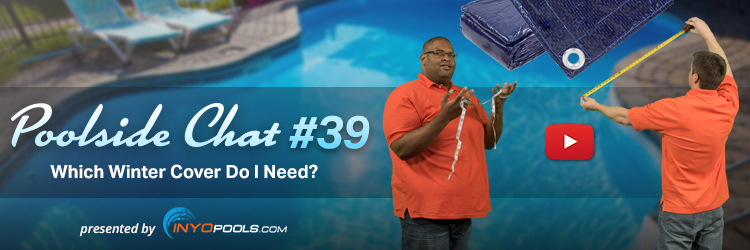







I live in an area that has freezing weather. I vacuum the water from the lines connected to the skimmers and use gizmos. Do you recommend doing anything to the return lines? I drain my pool 4″ below the skimmers but the returns are still well below water level. What would be the best way to remove water from the return lines, blow air into the filter basket line and plug the lines while blowing the air? I haven’t tried to clear the return lines in the past and have not had a problem so far.
The standard winterizing trick is either to blow out the lines and/or use a pool water antifreeze (NOT the normal antifreeze) to prevent plumbing line cracks over the winter. Do a youtube search on how to blow out pool water lines and there should be plenty of examples to choose from.
Is it absolutely necessary to wait for the water temperature to drop below 18 degrees C?
Can I winter it now and add more chemicals later if necessary?
I guess you could. I am not sure why you would want to install the cover, knowing full well you are going to at least partially remove it to properly mix the booster shot of chemicals a week or so later.
We live in Mocksville nc we was told that we could cover our pool and leave the pump running during the winter is this true?
I do not know what the typical winter is like in your area. I suggest asking other pool owners in your neighborhood if you know any. Find out what they typically do during the offseason. Also, if you have a pool tech or company you trust, ask them what the typical pool procedure for the winter is in your area.
How are you supposed to properly winterize a above ground pool main drain for the winter?
I live in Mississippi. Is it ok to drain the pump on an in ground salt water pool and not cover the pool? I don’t want to leave the pump running because on cold days it runs 24 hours and if we are out of town it would just be easier for it to be drained. But there are loose dogs in the neighborhood and also out of city limits so critters around. I am afraid one will get on the cover in the pool and not be able to get out. My question is, is it ok to winterize your pump but not put a cover on the pool?
Loose dogs and critters aside, it depends on the weather and surrounding foliage. If your weather is consistently 50 degrees and below then lowering the water level should be fine. Algae growth comes to a halt below 50 degrees, and bacteria should not be much of a problem either.
But if you are in a heavily wooded area where leaves, pine needles, and nuts will end up in your pool; you are going to need to find some way to get them out. If you let them set in your pool, then the remaining water in your pool will be a soup and could stain your pool surface.
I live in Southern California in an area where the temperature seldom gets below 40 degrees F at night, freezing has never been an issue. I have a DE filter with a variable speed pump for a pebbletech in-ground pool, roughly 16k gallons. I use a copper ionizing solar float along with chlorine to keep algae in control, although I have a bit of a build-up at the moment due having shoulder surgery. My wife asked if I we could just leave the pool without the pump running and let it algae up like her relatives back east used to do each year and then at the start of the pool season do a deep cleaning/shock to restore it. Is this feasible? I would certainly like to save on electricity and chemicals, my concern is that the pool could get so clogged with algae that we would have difficulty getting it going again in the spring. Additionally would this create a potential health issue with a large body of stagnant water with algae being a great breeding ground for mosquitoes?
I would probably just lessen the run time of your pool pump to a couple of hours a day if you plan to keep it open. The lower temps in winter mean there is less call for chlorine so there is less need to keep the water churning.
Pool algae require water temps to be around 60 degrees to bloom. If your water stays below 60 then algae shouldn’t be an issue. But if your water fluctuates will have a problem. And I am not sure how much money you would be saving in chemicals because you will likely have to shock, then re-shock, add algaecide and do the proper balancing of your pool water when you open the pool up having left it stagnant for months. Also, depending on your area, you could have staining issues as well.
Mosquitoes shut it down for the winter in temperatures below 50 degrees Fahrenheit, and prefer temps of 80 and above. If your area stays in the upper end of that scale, mosquitoes will be a problem.
I live outside of Dallas, Texas. We typically winterize and cover our inground saltwater pool. However, leaves and dirt still get under the cover and into the pool. It has been a nightmare with opening in the Spring
due to algae growth. What do you recommend? Should we leave the pool open?
Angela
I have come across quite a pool owners in Texas who never close their pool. But I do not know the volume of leafs and other debris you are dealing with in the fall that might make it unfeasible. Because Dallas is relatively warm weather most of the year, all you would need is a simple freeze protect sensor or keep your water constantly running. The latter option is only ideal if you have a dual or variable speed motor.
What type of cover are you using? It seems odd that enough leafs are slipping past a pool cover to cause an issue. If it is a winter cover, you might want to buy a few more water bags to form a solid ring barrier the leafs and dirt can’t get by.
I live in Austin, Texas. Do I need to winterize my above ground pool and does this include reducing the amount of water by 4-6 inches under the skimmer?
Randy – it depends on your climate. If you are expecting freezes, snow, and sleet than you should close it. If you don’t have a true winter like us in Florida, then you likely do not need to close the pool. In the warmer parts of the country, pool owners will simply reduce the run time of their pump because the demand for chlorine is not as high.
Hi Matthew,
My pool was closed for a full year.
I see that it seems like it just recently lost a lot of water as the pool cover is falling in much more.
Can I add water now or will that affect the winterization/chemicals?
Any other tips on this…
If the cover is in danger of falling into the pool, then I would suggest raising the water level. And whether or not you should add more chemicals would depend on the water chemistry result after you add that new water. But chances are, you are going to need to add more water.
Unfortunately, I do not have any tips for keeping a pool semi-permanently closed. But if you were able to keep it successfully closed for a year, I’d say, keep doing what you’re doing.
Re: Step 7 Cover your Pool. Would you please elaborate on “You have standard winter and mesh covers, leaf covers, and safety covers. We recommend you use a combination of the two to protect your pool.” How and in what combination?
Jon,
Thanks for reading our blog, The combination I recommend using is a leaf net on top of a winter cover. Sometimes when it’s time to open your pool again in the spring, large amount of water, leaves, and debris end up on top of your cover. By only having a winter cover, it makes removing the cover very difficult due to the weight of the water and debris. By putting a leaf net on top of your cover, it allows you to easily remove the leaves and large debris first. Then, removing your winter cover is much easier. The leaf net also serves as extra protection for your winter cover. Hope this helps.